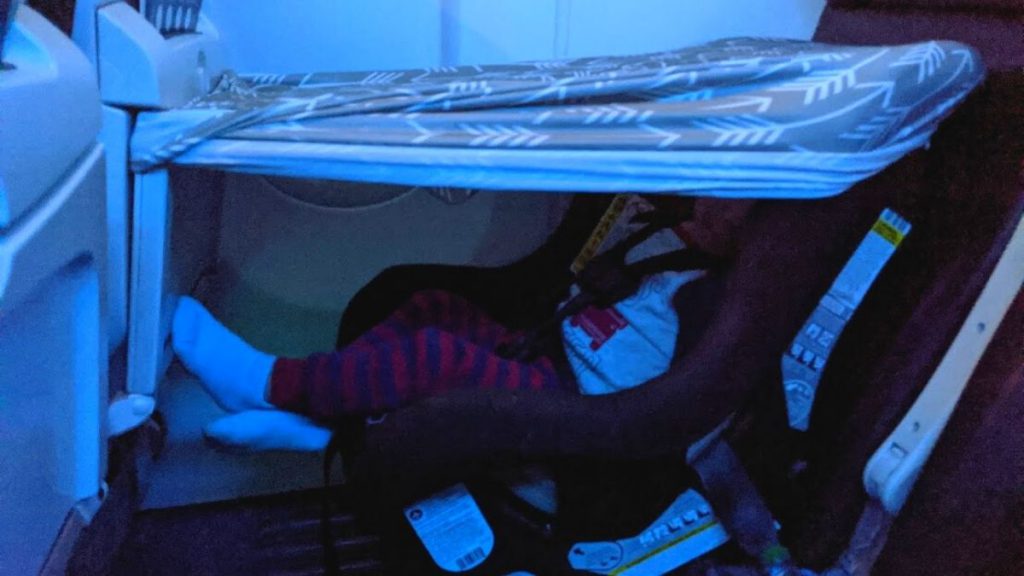This page may contain affiliate links, which means that we may earn from qualifying purchases at no additional cost to you.
The idea of a long flight with a toddler can be stressful, especially when you’re planning on having them sleep on the plane. How do you get a toddler to fall asleep in an exciting new environment with as little fuss as possible so as not to disturb the other passengers?
While there are no guarantees, there are things you can do to prepare for a smooth flight for you and your toddler.
On our many long flights with toddlers, we’ve had some really great sleep experiences as well as some not-so-great ones.
Along the way, we’ve learned a lot about what to do to give our toddlers the best chance of success.
Because when it comes down to it, they are still toddlers and you can never quite predict how things are going to go.
But with these tips up your sleeve, you’ll be prepared with the best possible chance of getting your toddler to sleep on the plane!
For a list of helpful travel items, see our ultimate list of toddler travel essentials!
Tips for getting a toddler to sleep on the plane
Prep your child before the trip


Before you leave on your trip, talk about the flight and what will happen. Explain to your child what will happen on the flight and that they will be having their bedtime on a plane.
You can even practice beforehand, pretending that you’re boarding the plane and going through all the steps you will follow to help them fall asleep. That way when you do board the plane it won’t be a surprise and they will know what to expect.
This definitely works best with older toddlers, but even with young toddlers, it can help to walk through it if only to help you plan and think through the things you want to bring/do to help your child prepare for sleep.
Incorporate your bedtime routine
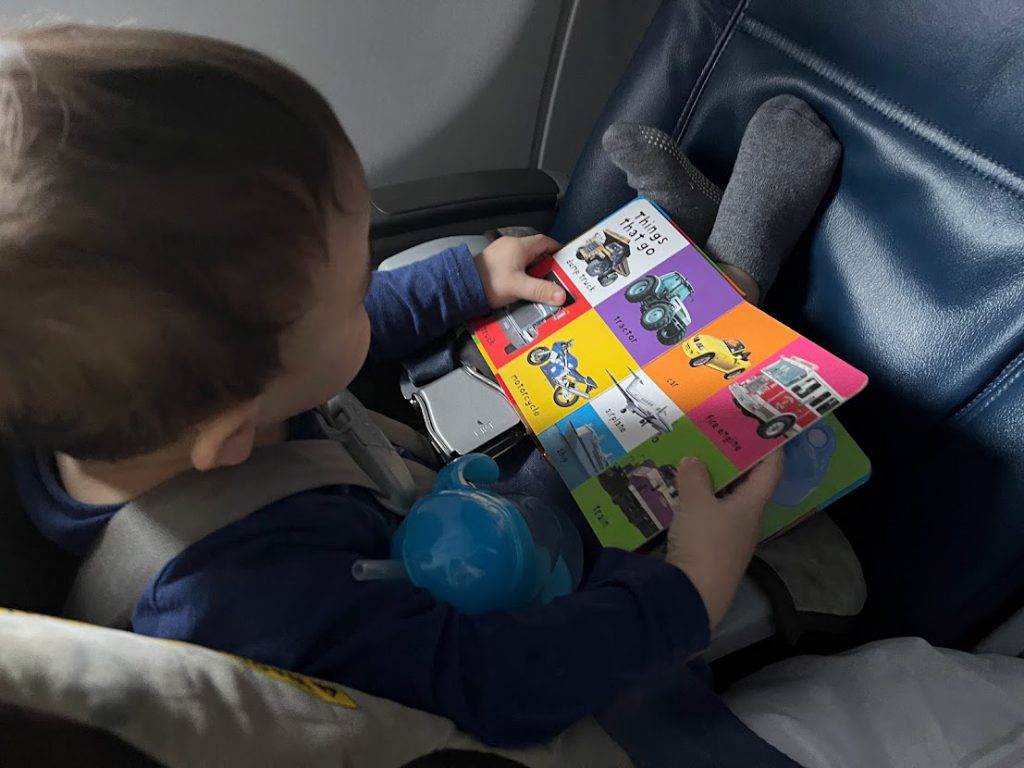

Set your child up for success by incorporating as many elements of their bedtime or naptime routine as possible. This mentally prepares them for sleep and helps their body to start winding down.
Have them wear their pajamas onto the plane if you’re flying at night, bring that book they love to read at bedtime, sing their favorite song, and don’t forget a pacifier (or two or three!) if they typically use one for sleep.
Bring a comfort item/lovey
If your child has a stuffed animal or blanket that they are used to having when they fall asleep, be sure to bring it with you on the plane.
This will help them to feel comfortable and safe in a new environment and trigger their body to sleep.
Get your toddler their own seat
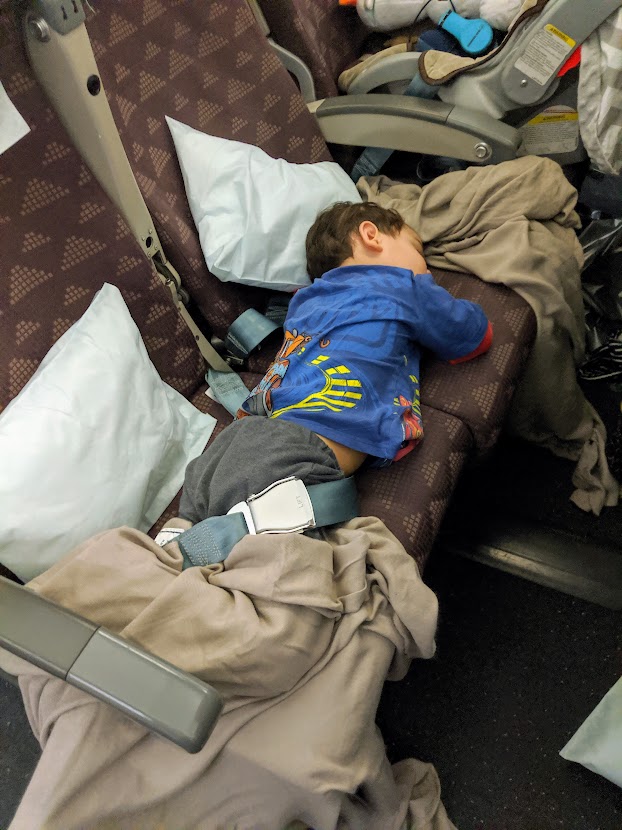

Especially for long flights, getting your toddler their own seat is one of the best ways to ensure that they (and you!) get some sleep on the plane.
With their own seat, you can bring their car seat or an airplane bed and your toddler has their own space to spread out. And the added benefit is that you don’t have to hold them the whole flight.
Now I will admit that we don’t always buy our toddlers their own seat before they turn two. But we’ve had a lot of luck getting a seat for our toddler when our flight isn’t fully booked by asking at the gate. And it is a gamechanger when they have their own seat.
We’re comfortable with the possibility that we might not get a seat for our toddler, but if you want the guarantee of a seat for your child, plan on buying a ticket for them. Obviously, this increases the cost of your trip, but it really does make for a much more pleasant flight experience for everyone involved.
If you aren’t planning on buying a seat, be sure to ask at the gate if there are any free seats on the plane. Often they can make accommodations if there is an extra seat available.
Also, when you’re booking your seats select the window and aisle seat, leaving the middle seat free. People are less likely to choose a middle seat, so you have a higher chance of that seat being left empty. If someone does sit there, they will most likely be happy to trade for an aisle or window seat so you can all sit together.
Consider using your child’s car seat


If you do have a seat for your toddler, you might want to bring their car seat for the flight. The car seat is the safest way to secure a toddler on a plane. It’s also a convenient way to restrain your child and get them to hold still long enough to fall asleep.
For a lot of toddlers, their car seat is a place they are used to sleeping in if they ever fall asleep in the car, making it a familiar sleep option for them.
The downside is that some toddlers do not sleep well in a car seat, especially for long flights where they aren’t able to move around to get comfortable while sleeping.
You’ll have to consider your child and what you think would be the best option for them.
Bring a toddler airplane bed
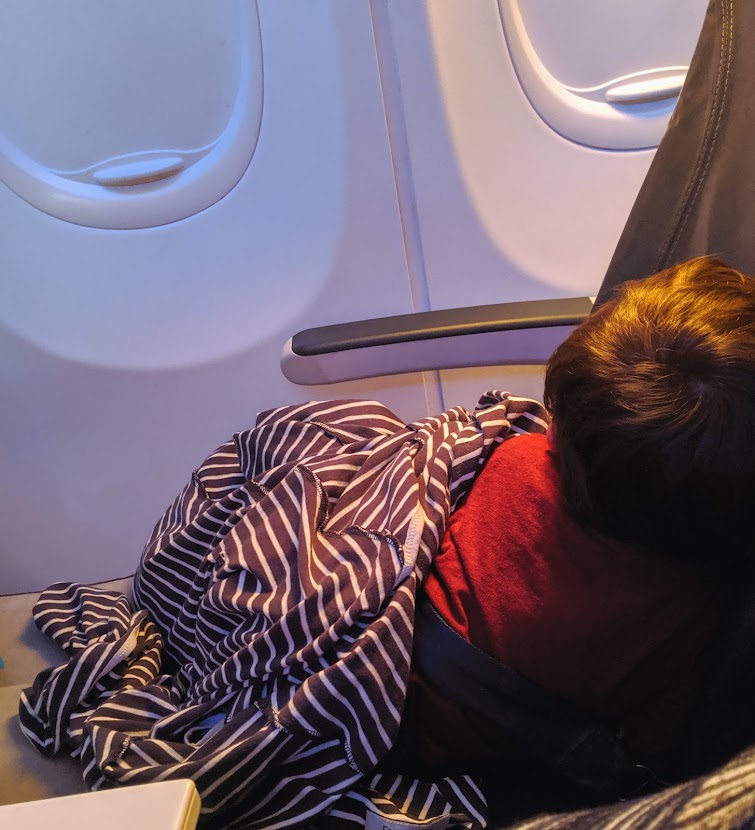

An alternative to a car seat is an airplane bed. An airplane bed is a great way to extend the seat and provide a comfortable place for your child to rest.
These compact and portable beds allow you to create a comfortable sleep space for your child where they can stretch out and fully extend their legs, making it easier for them to fall asleep.
See this post for a breakdown of the best toddler airplane beds on the market.
Whether or not to bring a car seat or an airplane bed really depends on your child’s personality and your preferences as a parent. Some kids sleep awesome in their car seats, but others might do better in a situation where they can spread out and lie flat. We’ve used both for our kids over the years and I can honestly say that for us it totally depended on the child which one worked best.
Plan the timing of your flight
When possible, plan the timing of your flight to set your child up for success. We’ve found that the best times to fly with a toddler are typically either a midmorning flight for shorter flights or a late evening flight for longer, international travel.
In both cases, you’re not waking them up early from sleep or their nap, so they’re not starting out in a sleep deficit before you even leave. It’s often not a great idea to wake a toddler up for a late or super early flight because then they start off tired and grumpy and there’s no guarantee they will fall back asleep.
A midmorning flight allows your child to get a full night’s sleep before you set out, and if you’re lucky they’ll play for a little bit on the plane and then take a nap.
An evening flight means that you’re boarding right around their bedtime so hopefully they will be ready to settle in for a good night’s sleep once the plane is in the air. The other benefit of a nighttime flight is that the lights are dimmed and fewer people are moving around and making noise, creating a better sleep environment. (Of course, that also means that if your child doesn’t sleep, it can be stressful trying to keep them quiet so they don’t disturb the other passengers trying to sleep).
That being said, we’ve had many instances where we had to fly at less than ideal times and we made it work (and other times where we flew at an ideal time and for some reason or another our toddler still didn’t sleep), so if there aren’t a lot of good options don’t worry about it too much.
Block out light


To aid your child in falling and staying asleep, try to block the light and distractions as much as possible.
Use a nursing cover, car seat cover, or blanket to cover your child’s seat and reduce the amount of light coming in.
Typically for long flights, the flight crew will dim the lights for a large portion of the flight, which definitely helps as well.
Even then, we always seem to sit by that person who refuses to close their window, letting light stream into the plane and totally ruining the illusion of nighttime. So it’s always nice to have something you can use to cover your child and prevent any ambient light from waking them up.
Plan a feeding right before sleep
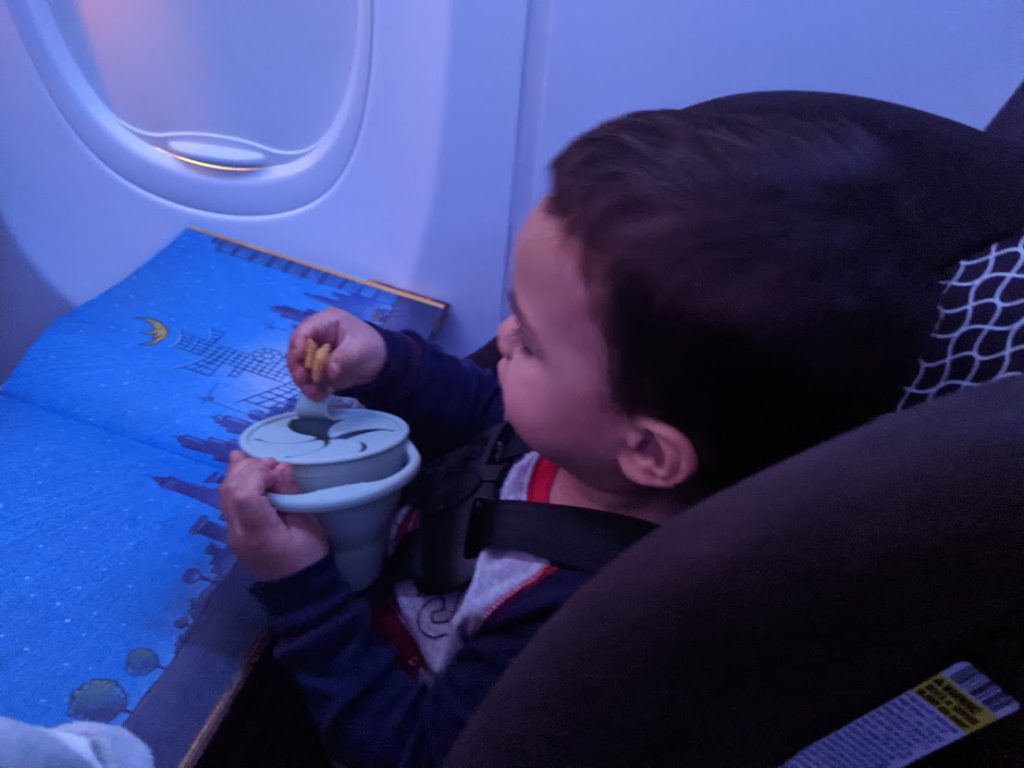

Plan ahead to give your child a feeding right before you want them to fall asleep.
If you’re still breastfeeding, nursing is a perfect way to get your toddler drowsy and ready to fall asleep on the plane.
If you’re not nursing, still plan to feed your toddler food or a bottle right before sleep time. A full stomach can make a toddler sleepy and it means they might sleep longer if they don’t need to wake up to eat.
Use a baby carrier if necessary


If your toddler is having a hard time falling asleep in their seat (or if they don’t have their own seat), a baby/toddler carrier is a great alternative to getting your child to sleep.
Strap them into the carrier and spend some time walking up and down the aisle and bouncing them to help them fall asleep. It’s also very helpful to cover them with a nursing cover if they will allow it to block out light and distractions.
Once they are fully asleep, you can sit back down and relax a little yourself (although I’m quick to jump back up and bounce them again if they start stirring to prevent them from fully waking up).
Note that this method can lead to some protests in the beginning as they might not want to be strapped in a carrier if they are having fun playing or are overtired. But if they are tired enough, often if you push through those first few minutes of frustration they will fall asleep and you can get a break.
We’ve used this strategy many times with our kids on flights. In fact, on our last flight to the Netherlands, this was the only way I was able to get our toddler to finally sleep on the plane.
Carriers can’t be used for take-off and landing, but if I have a child sleeping in a carrier I’ll just unbuckle the shoulder straps of the carrier and pull it down, doing my best to leave the baby sleeping on my chest.
Be prepared in case they don’t sleep


Know that in the end, some toddlers just don’t sleep well on planes. Even if you do everything “right”, you might end up with a wide-awake toddler.
Despite all of our best efforts, we’ve had the occasional flight where our toddler doesn’t sleep at all or only sleeps a few hours.
So prepare in advance knowing that this might be the outcome. Bring engaging toddler airplane activities to keep your child engaged and pack toddler snacks to distract them if they start melting down. Take occasional breaks to walk up and down the aisle and trade-off toddler duty with your partner if possible.
After a while try again to see if they will sleep. If not, back to the airplane activities and distractions.
I also find it helps my mental state if I have a good book prepped and ready to go on my Kindle. Then when my child is having a hard time I think, “Well, now maybe I have a few minutes to read that great book I’ve been meaning to get to.” I’ll read on and off while I help my child with their airplane activities and the time won’t seem to go so slowly.
This was very effective on a recent 10-hour nighttime flight where our toddler only slept for 40 minutes the whole flight… It sounds like a nightmare, but it wasn’t nearly as bad as you might think.
And keep reminding yourself that eventually the flight will end, even if it doesn’t feel like it in that moment.
Common questions about toddler airplane sleep
Can toddlers sleep on the airplane floor?
No, a toddler cannot sleep on the floor of the airplane. It’s not safe, it’s not sanitary, and it’s not allowed by airlines.
Your toddler will need to be either in your arms or in their own seat for the duration of the flight.
What can I give my toddler to sleep on the plane?
Melatonin is a supplement that is often recommended for helping children to sleep on a plane or adjust to a new time zone. It works by helping to regulate circadian rhythms and cue your body for sleep.
Some people also recommend Benedryl for helping children to sleep on the plane. Just be aware that for some children, Benedryl has the opposite effect and can actually make them more wired (just what you want on a plane…).
We’ve never used either of these options, but know that some people swear by them. Do your own research and consult a pediatrician to find the best option for you and your child.
Final Thoughts
Flying with a toddler, while not the most relaxing experience, doesn’t have to be insanely stressful.
Plan ahead as best you can to help your toddler sleep on the plane and then be prepared to be flexible and roll with the punches once you’re actually on your flight.
If you follow these tips, with luck you’ll find yourself with a sleeping toddler and a relaxing flight. And if not, just know that we’ve been there too! Hopefully you’ll have better luck next time.
Other posts you might be interested in:
The Best Airplane Beds for Toddlers
21 Airplane Toys and Activities Your Toddler Will LOVE!
The Best Airplane Snacks for Toddlers
How to Fight Jet Lag in Babies and Toddlers
How to Gate Check a Stroller

